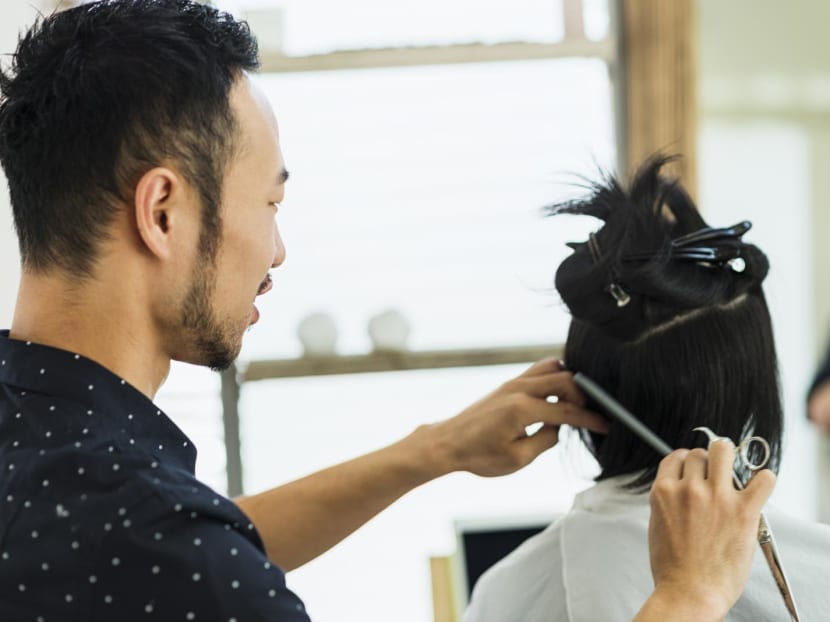Did you just get a bad haircut? Here’s how to fix it according to a celebrity stylist
A bad haircut can feel like the end of the world – just ask model-actress Emily Ratajkowski. We spoke to a celebrity hairstylist to find out what to do when your cut goes wrong, and how to make sure it doesn’t happen again.

Here's how to deal with a bad haircut. (Photo: iStock)

This audio is generated by an AI tool.
A couple of months ago, American supermodel and actress Emily Ratajkowski posted a TikTok meltdown over her choppy new haircut. “I have the worst haircut of my life,” she lamented in her viral clip, tugging at the blunt, uneven layers.
Judging from the thousands of comments on her post, her experience had obviously struck a chord with her followers. And this candid moment confirms a universal truth: Not even celebrities with access to the world's top stylists are immune to haircut regret.
Whether it's a too-short fringe, lopsided layers, or a style that simply doesn't complement your face or vibe, a bad haircut can seriously shake your confidence. But it doesn't have to derail your entire month – or even your week.
We spoke to Junz Loke, creative director and co-founder of hair salon 35A, to find out what you can do when you hate your cut, and how to prevent disappointment in the future.
FIRST, DON’T PANIC – AND DON’T SUFFER IN SILENCE
Your initial reaction might be to freak out. But take a deep breath – most haircut disasters are fixable. Whether the issue is length, shape, or suitability, a skilled stylist can often work with what you've got.
According to Loke, who has styled model Irene Kim and actress Chen Yixin, honest communication is essential.
“As a stylist, it’s important to create a space where clients feel safe being honest, especially if something doesn’t feel quite right with their cut or colour,” he explained. “Many people are afraid to speak up because they don’t want to seem rude. That’s why I invite feedback before they even have to ask – like, ‘Let me know if there’s anything you’d like to tweak?’”
Loke added that normalising follow-up adjustments can be reassuring. “If they seem hesitant but say they’re ‘fine,’ reminding them that they can reach out in the next few days shows that you’re committed to making sure they leave feeling confident.”
And if you do voice your concerns? A professional stylist won't take offence. “I don’t take it personally, because I know how personal hair can be, and I want them to feel supported,” shared Loke. “When someone’s unhappy, my first priority is to stay grounded and open. I’ll usually start by saying something like, ‘I hear you, let’s talk through it together and see how I can help,’ to create a safe, non-judgmental space.”
His next step is to offer a plan, whether it’s an immediate adjustment, styling techniques to enhance the cut, or a follow-up appointment.
The key, Loke explained, is to shift the client from panic into clarity. “Even if it’s something that can’t be fully fixed right away, I want them to know I’ve got their back. I often check in after, just to see how they’re feeling.”
WHAT HAPPENS DURING A CORRECTIVE CUT
If you’re too uncomfortable to return to the same stylist, another professional can help. “Corrective cuts are actually pretty common,” explained Loke. “When someone comes in with a bad cut from somewhere else, I know they’re probably feeling frustrated, nervous, or even embarrassed.”
His process starts with attentive listening. “I ask specific questions to understand what went wrong – was it the shape, the length, or the texture? Then I manage expectations. I’ll explain what’s possible in that moment and what might take time to grow out or gradually reshape.”
Loke approaches every snip with intention. “I focus on creating balance, softness, or structure depending on what’s needed, and I always talk them through what I’m doing so they feel included and reassured.”
Beyond mere correction, Loke aims to restore his clients’ sense of self. “I want them to feel confident, comfortable, and seen.”
QUICK FIXES WHEN THINGS GO WRONG
If you’re stuck waiting for your hair to grow out, try these styling tricks to make it work in the meantime:
- Too short bangs: Sweep them to the side or blend into curtain bangs. Use a round brush and hairdryer (or straightener) to soften the shape.
- Too choppy or uneven layers: Curling or waving your hair can help blend the layers and make harsh lines less noticeable. Use texturising spray or mousse for added softness and movement. (Fun fact: This was exactly how EmRata’s other stylist swooped in to save the day.)
- Too blunt or bulky ends: Styling with a curling iron or flat iron (with a slight bend) can add dimension. A bit of smoothing cream or hair oil helps tame puffiness and adds polish.
- Too short cuts: Hair extensions, like clip-ins, halos, or ponytail pieces, can add length and volume instantly. Opt for human hair extensions if you want to heat-style them to match your texture.
- Too flat or shapeless hair: Use volumising products like root-lifting spray, dry shampoo, or a texturising powder. Flipping your part or adding loose waves can also help fake fullness and structure.
- When all else fails? Accessorise: A scarf or hat can be your best friend on tough hair days. Headbands, claw clips, and strategically placed bobby pins do more than hide a bad haircut – they can make it look intentional.
HOW TO GET A GOOD HAIRCUT
Preventing a bad haircut starts before the scissors even come out. Here’s how to make sure your next chop doesn’t end in regret:
1. BRING REFERENCES
Loke swears by a thorough consultation: “One that’s honest, specific, and visual.”
“Bringing reference photos is super helpful – both of styles you love and ones you don’t – so there’s no confusion about what you’re envisioning. It’s also important to be real about your daily hair routine, whether you air-dry, heat-style, or throw it up most days because that helps your stylist create a cut that fits your lifestyle, not just looks good in the chair.”
2. WORK WITH YOUR STYLIST TO REFINE YOUR CUT
Sometimes you want a change but don’t know what exactly – and that’s totally okay. A good stylist will guide you through designing a new look together.
“When someone says they just want ‘a change,’ or gives super vague instructions based on a vibe, like ‘I want it to feel lighter’ or ‘more edgy’, I see it as an invitation to really dig in and guide the process,” said Loke.
“I’ll ask things like: ‘Are you thinking bold or subtle? Do you want more texture? Shorter length? Maybe a fringe? 'From there, I get a sense of their comfort zone, how much they’re willing to shift, and what they definitely don’t want.”
3. DON’T RUSH INTO A TRENDY CUT
Just because a style is popular (or worn by your favourite celeb) doesn’t mean it’s right for you – or that it should be done on impulse.
Loke pointed out that even celebrities who have access to top-tier stylists can end up with bad haircuts. “It usually comes down to the same things that trip up everyone else: Miscommunication, rushed decisions, or trying to force a style that doesn’t suit their natural hair or lifestyle.”
“Sometimes, celebrities are under pressure to switch things up quickly for a role, red carpet moment, or brand deal, and that fast turnaround doesn’t always leave time for thoughtful planning,” he added.
That viral cut you saved might look incredible on TikTok, but it’s worth asking: Does it suit your face shape? Your hair texture? Your day-to-day styling habits? If you’re unsure, take your time. Book a consultation, talk it through, and make sure your stylist is honest about what works and what doesn’t.
THE FINAL CUT
Whether you're still lamenting a botched fringe or currently living your best hair life, remember that even supermodels have their moments of hair despair. And like EmRata – who bounced back with a beautifully styled solution just two weeks after her viral meltdown – you too can transform a hair disaster into just another chapter of your style evolution.
After all, in the grand timeline of your hair journey, even the worst cut is temporary. But the confidence that comes from knowing how to navigate these moments? That's a style statement that never goes out of fashion.





